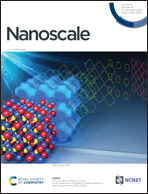Revealing the NIR-triggered chemotherapy therapeutic window of magnetic and thermoresponsive nanogels†
Abstract
The combination of magnetic nanoparticles and thermoresponsive nanogels represents an appealing strategy for the development of theranostic probes. These hybrid nanocarriers present several advantages such as outstanding properties for guided therapy, magnetic resonance imaging, and triggered release of encapsulated cargoes. Most magnetic thermoresponsive nanogels are built with strategies that comprise a physical interaction of particles with the polymeric network or the covalent attachment of a single particle to the linear polymer. Herein, we report a facile synthetic approach for the synthesis of magnetic and thermoresponsive nanogels that allows the controlled incorporation of multiple superparamagnetic inorganic cores as covalent cross-linkers. An ultrasonication-assisted precipitation–polymerization afforded nanogels with sizes in the nanometric range and similar magnetization and light transduction properties compared to the discrete magnetic nanoparticles. The theranostic capability of these nanocarriers was further investigated both in vitro and in vivo. In vivo experiments demonstrated the capacity of these materials as nanocarriers for near-infrared (NIR) triggered chemotherapy and highlighted the relevance of the correct concentration/dose in this antitumoral modality to achieve a superior therapeutic efficacy.

- This article is part of the themed collection: Editor’s Choice: Recent breakthroughs in nanobiotechnology


 Please wait while we load your content...
Please wait while we load your content...